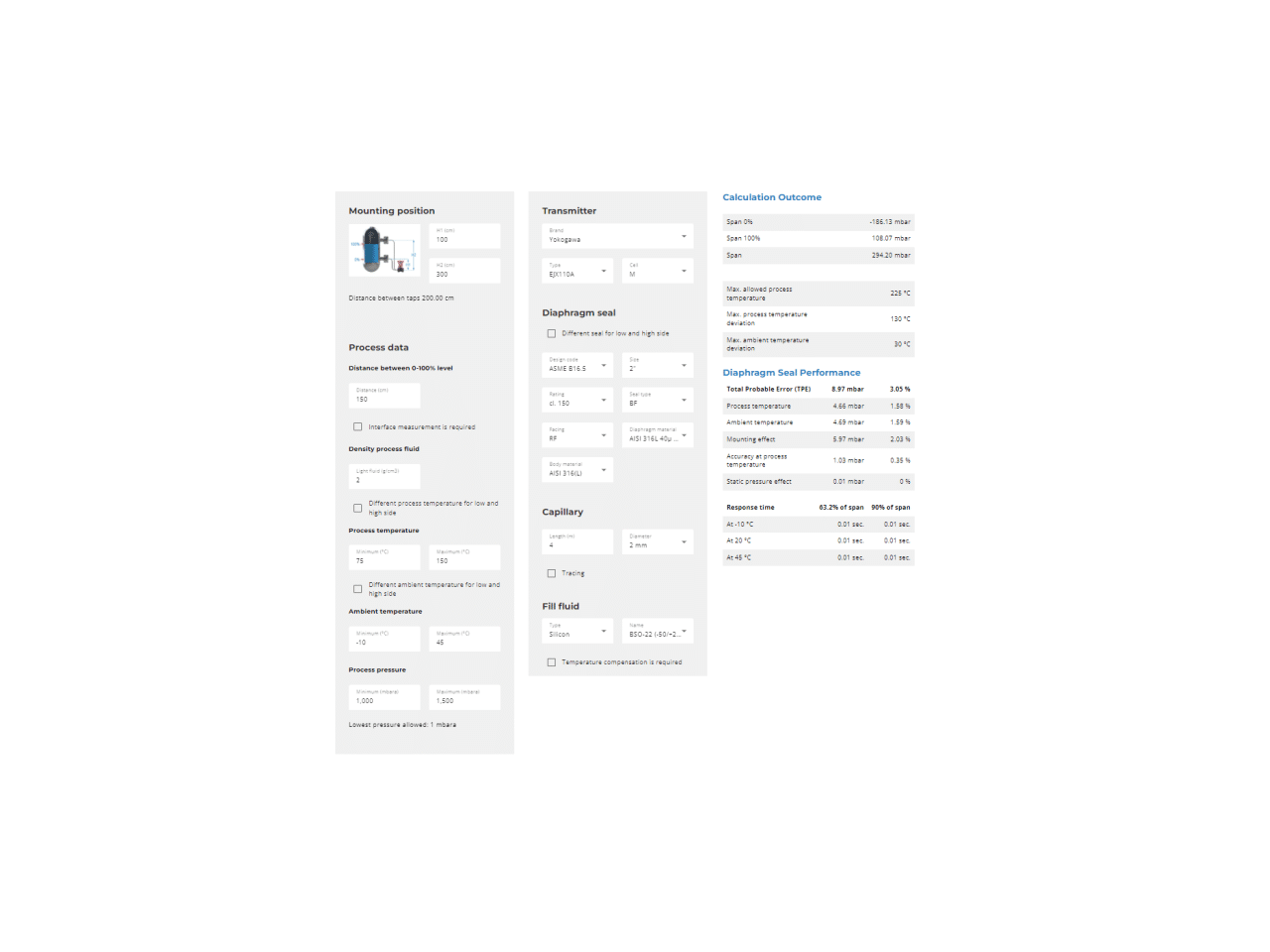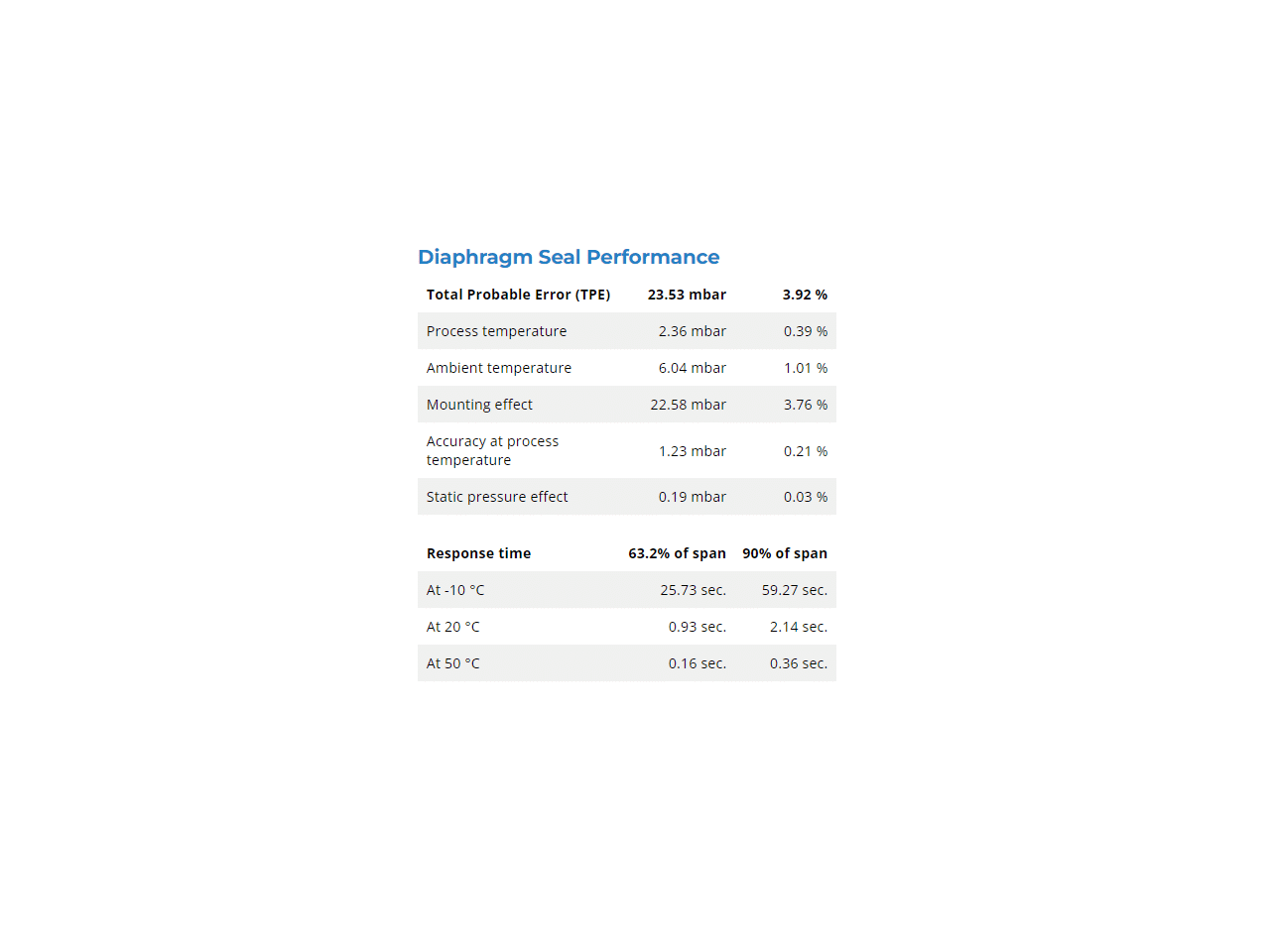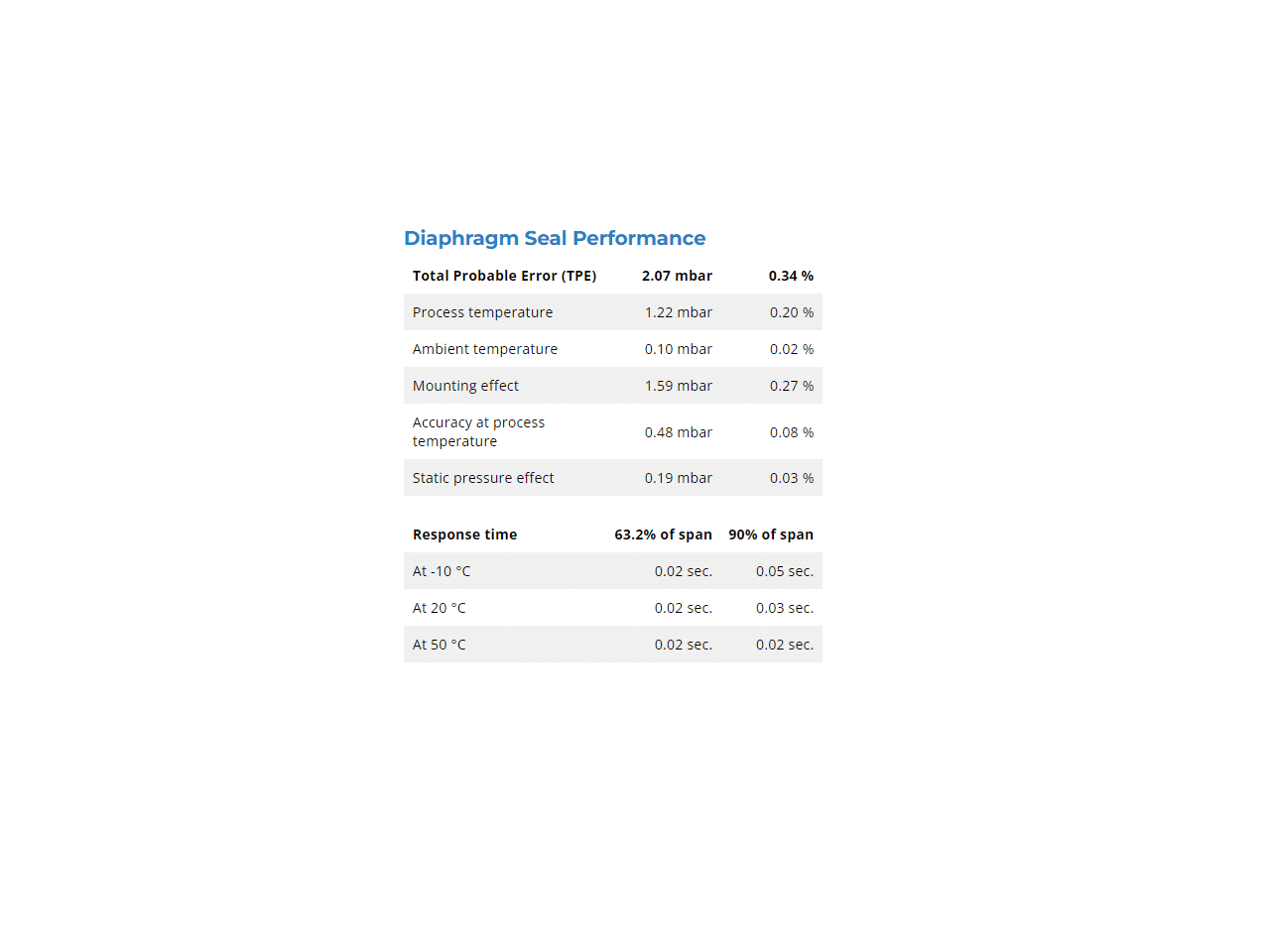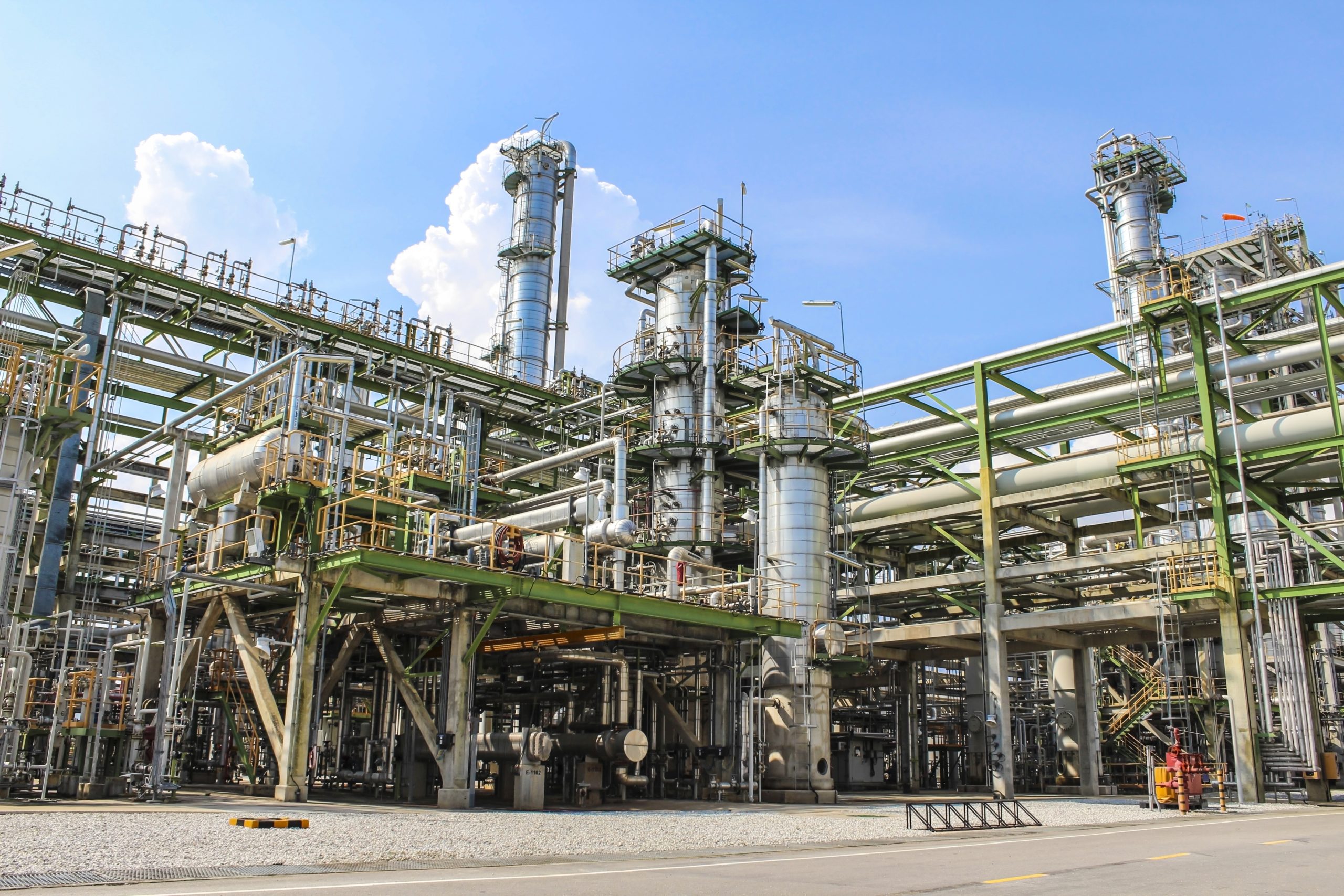BaseCal is intended to be used by instrument engineers at end users and transmitter manufacturers that are actively working with Badotherm Diaphragm Seals systems. The outcomes and results are only applicable to Badotherm manufactured diaphragm seal system. To make use of the BaseCal software, you may apply for an account through the link below. Your application will then be processed and evaluated by our Sales Team. Should you have any further questions, please do let us know.
In case of incidental use, it is easier and more convenient for you that a Badotherm sales engineer takes you through your specific request. Interested and need a hand, please schedule your meeting by contacting our sales team.
BaseCal is a tool that considers all process and ambient conditions such as pressure to be measured, the ambient and process temperatures, and the actual mounting position of the complete diaphragm seal system. Resulting in an easy one-page report with a clear TPE outcome. See below in more detail the factors that BaseCal takes into account.

Showing the error of a combined effect of the fill fluid characteristics and its related expansion or contraction error of the seal volume. This is based on the volumetric displacement of the diaphragm, which is dependent on thickness, diameter and material of construction. All based on the maximum process temperature.
Showing the error of a combined effect of the fill fluid characteristics and its related expansion or contraction error of the seal volume. This is based on the volumetric displacement of the diaphragm, which is dependent on thickness, diameter and material of construction. All based on the maximum process temperature.
Showing the error of a combined effect of the fill fluid characteristics and its related expansion or contraction error of the system volume (capillary + transmitter) showing the effect based on the maximum ambient temperature deviation.
Showing the error of a combined effect of the fill fluid characteristics and its related expansion or contraction error of the system volume (capillary + transmitter) showing the effect based on the maximum ambient temperature deviation.
Showing the error based on the (vertical) mounting of the transmitter and the diaphragm seals, taking also into account the change in density of the fill fluid based on the maximum ambient temperature deviation, and thus the pressure of the liquid column of the fill fluid.
Showing the error based on the (vertical) mounting of the transmitter and the diaphragm seals, taking also into account the change in density of the fill fluid based on the maximum ambient temperature deviation, and thus the pressure of the liquid column of the fill fluid.
Showing the combined error based on the accuracy of the selected transmitter and the error of the selected diaphragm, taking into account the span effects related to the temperature effects.
Showing the combined error based on the accuracy of the selected transmitter and the error of the selected diaphragm, taking into account the span effects related to the temperature effects.
Showing the error based on the static pressure effect of the selected transmitter and selected diaphragm seal application (only applicable for dP measurements).
Showing the error based on the static pressure effect of the selected transmitter and selected diaphragm seal application (only applicable for dP measurements).
It is difficult to make a general statement on the performance of any diaphragm seal application based on only one single effect or factor. It is the combination of the set of factors that determines the total performance. Statistical mathematics shows that the most realistic way to combine the effects of independent factors is by using the root-sum-square (RSS) method instead of just summing or averaging them. The result of the RSS method is what we refer to as the Total Probable Error of the diaphragm seal application. BaseCal’s TPE is based on the following effects :
It is difficult to make a general statement on the performance of any diaphragm seal application based on only one single effect or factor. It is the combination of the set of factors that determines the total performance. Statistical mathematics shows that the most realistic way to combine the effects of independent factors is by using the root-sum-square (RSS) method instead of just summing or averaging them. The result of the RSS method is what we refer to as the Total Probable Error of the diaphragm seal application. BaseCal’s TPE is based on the following effects :
The response time is defined as the time lag between the pressure response in the pressure measuring instrument (e.g., moment when reaching 63.2 % or 90 % of the total pressure change) and the step-change moment of the process-medium pressure.
The response time is defined as the time lag between the pressure response in the pressure measuring instrument (e.g., moment when reaching 63.2 % or 90 % of the total pressure change) and the step-change moment of the process-medium pressure.
With BaseCal it is possible to show the difference between a well-engineered diaphragm seal application and a poor designed application. See below calculation example, based on a level measurement.
Mounting position: Style 2| H1: 50 cm | H2: 850cm
Process data: Distance between 0-100% level: 600cm | Density process fluid: 1.02 g/cm2 | Maximum process temperature: 125 °C | Ambient temperature from 10°C to 55°C | Process pressure from 1050 to 15000 mbara
Diaphragm seal: size: 2” | type: BC | diaphragm material: AISI 316L
Capillary: length: 17mtr | diameter: 1mm
Filling Fluid: type: silicon| name: BSO-21
Based on these characteristics the following errors are calculated in BaseCal. The TPE is 23.53 mbar which is equal to 3.92% of the span. The Response Time at 90% of the span at -10°C is 59.27 seconds.



BaseCal is designed to support the user in selecting the correct diaphragm seal configuration to measure level, pressure, or differential pressure. It is not only the selection of the type of diaphragm seal that is important, but mostly the combination of all critical values that determine the performance of the application. BaseCal uses exclusionary logic to align Badotherm diaphragm seals with a variety of well-known industrial transmitters.
BaseCal provides a total probable error (TPE) and response time based on the process conditions. It is important to know that BaseCal is independent and will not favour any particular solution or transmitter manufacturer. The outcome of a correct selected configuration and the diaphragm seal performance are warranted by Badotherm. This warranty is only valid when the diaphragm seal application is assembled and tested by Badotherm.
For more information on BaseCal get in touch with our Sales team or download the brochure for more details.